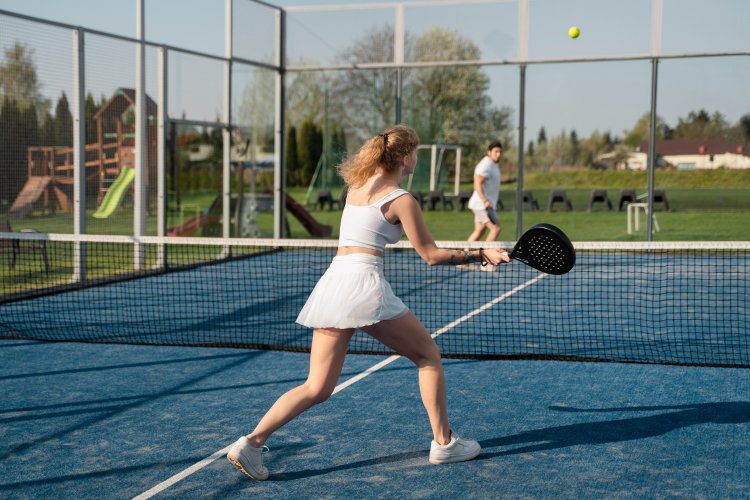A Guide to Choose the Right Flooring for Your Badminton Court
Read to learn how to select the perfect flooring for your badminton court. Our guide covers the best options, materials, and tips for enhancing your playing experience.
Share this Post to earn Money ( Upto ₹100 per 1000 Views )

Badminton is a dynamic and fast-paced sport that demands not only skill but also a suitable playing environment. One crucial aspect of creating an optimal badminton environment is selecting the right flooring for your court. The flooring you choose can significantly impact the players' performance, safety, and overall playing experience. This guide will help you navigate the various options and considerations for choosing the best flooring for your badminton court.
Understanding the Importance of Flooring
The flooring in a badminton court is more than just a surface to play on. It plays a vital role in providing proper traction, shock absorption, and durability. The right flooring can enhance players' movements, reduce the risk of injuries, and ensure a consistent playing experience. Whether you're setting up a new court or renovating an existing one, understanding the key factors that influence the choice of flooring is essential. If you're setting up a badminton court Sharjah, for instance, the climate and usage frequency might also affect your decision.
Types of Badminton Court Flooring

Several types of flooring are commonly used in badminton courts, each with its unique features and benefits. Here are the main types:
1. Wooden Flooring
Wooden flooring is a traditional and popular choice for badminton courts. It offers excellent shock absorption, which is crucial for reducing the impact on players' joints. Wooden floors provide a natural feel and are highly durable, making them suitable for high-frequency use. However, they require regular maintenance to prevent damage from moisture and wear.
2. Synthetic Flooring
Synthetic flooring, such as PVC or vinyl, has gained popularity due to its versatility and low maintenance. These floors offer good traction and shock absorption, providing a comfortable playing surface. They are also resistant to moisture, making them ideal for indoor courts. Synthetic flooring is available in various thicknesses and designs, allowing customization based on specific needs.
3. Rubber Flooring
Rubber flooring is known for its excellent shock absorption and slip resistance. It provides a cushioned surface that reduces the risk of injuries. Rubber floors are durable and can withstand heavy use, making them suitable for both indoor and outdoor courts. They are also relatively easy to maintain and clean.
4. Acrylic Flooring
Acrylic flooring is commonly used for outdoor badminton courts. It offers a hard and durable surface that can withstand harsh weather conditions. Acrylic floors provide good traction and are available in various colors and finishes. While they may not offer the same level of shock absorption as wooden or synthetic floors, they are a cost-effective option for outdoor use.
Have a look: badminton classes near me | Gurugram
Factors to Consider When Choosing Flooring
Selecting the right flooring for your badminton court involves considering several factors that influence performance, safety, and longevity. Here are the key factors to keep in mind:
1. Usage Frequency
The frequency of use is a critical factor in determining the type of flooring. High-traffic courts require durable and low-maintenance flooring options like synthetic or rubber. For courts with moderate usage, wooden flooring can be an excellent choice due to its superior shock absorption.
2. Indoor vs. Outdoor
The location of your badminton court (indoor or outdoor) will significantly impact your flooring choice. Indoor courts benefit from wooden or synthetic flooring due to their shock absorption and comfort. Outdoor courts, exposed to the elements, are better suited for acrylic or rubber flooring, which can withstand varying weather conditions.
3. Budget
Budget is always a crucial consideration. While wooden flooring offers excellent performance, it can be more expensive to install and maintain. Synthetic and rubber flooring options provide a balance between performance and cost-effectiveness. Acrylic flooring is often the most affordable option for outdoor courts.
4. Maintenance
The level of maintenance required for different types of flooring varies. Wooden floors need regular polishing and protection from moisture. Synthetic and rubber floors are easier to maintain, requiring simple cleaning and occasional inspections. Acrylic floors require minimal maintenance but should be checked for cracks or wear over time.
Installation and Maintenance Tips
Proper installation and maintenance are vital for ensuring the longevity and performance of your badminton court flooring. Here are some tips to keep in mind:
1. Professional Installation
Hiring professionals for the installation ensures that the flooring is laid correctly, providing a level and durable surface. They can also offer advice on the best type of flooring based on your specific requirements.
2. Regular Cleaning
Regular cleaning is essential to maintain the surface's quality and performance. Use appropriate cleaning agents and equipment to prevent damage. For wooden floors, avoid excessive water to prevent warping.
3. Inspection and Repairs
Regularly inspect the flooring for signs of wear, damage, or unevenness. Promptly address any issues to prevent further deterioration. For wooden floors, reapply polish and sealants as needed to protect against moisture and wear.
Final Summary
Choosing the right flooring for your badminton court is a crucial decision that impacts the playing experience, safety, and longevity of the court. By considering factors such as usage frequency, location, budget, and maintenance, you can select the most suitable flooring option. Whether you opt for the traditional feel of wooden flooring or the versatility of synthetic materials, proper installation and maintenance will ensure your badminton court remains in top condition for years to come.
















